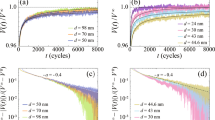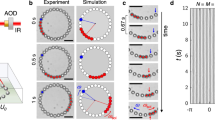Abstract
A single particle confined in an asymmetric potential demonstrates an anticipated ratchet effect by drifting along the ‘easy’ ratchet direction when subjected to non-equilibrium fluctuations1,2,3. This well-known effect can, however, be dramatically changed if the potential captures several interacting particles. Here we demonstrate that the inter-particle interactions in a chain of repelling particles captured by a ratchet potential can, in a controllable way, lead to multiple drift reversals, with the drift sign alternating from positive to negative as the number of particles per ratchet period changes from odd to even. To demonstrate experimentally the validity of this very general prediction, we performed transport measurements on a.c.-driven vortices trapped in a superconductor by an array of nanometre-scale asymmetric traps. We found that the direction of the vortex drift does undergo multiple reversals as the vortex density is increased, in excellent agreement with the model predictions. This drastic change in the drift behaviour between single- and multi-particle systems can shed some light on the different behaviour of ratchets and biomembranes4 in two drift regimes: diluted (single particles) and concentrated (interacting particles).
This is a preview of subscription content, access via your institution
Access options
Subscribe to this journal
Receive 51 print issues and online access
$199.00 per year
only $3.90 per issue
Buy this article
- Purchase on Springer Link
- Instant access to full article PDF
Prices may be subject to local taxes which are calculated during checkout




Similar content being viewed by others
References
von Smoluchowski, M. Experimentell nachweisbare, der üblichen Thermodynamik widersprechende Molekularphänomene. Phys. Z. 13, 1069–1080 (1912)
Feynman, R. P., Leighton, R. B. & Sands, M. The Feynman Lectures On Physics Ch. 46 Vol. 1 (Addison-Wesley, Reading, Massachusetts, 1966)
Magnasco, M. O. Forced thermal ratchets. Phys. Rev. Lett. 71, 1477–1481 (1993)
Morais-Cabral, J. H., Zhou, Y. & MacKinnon, H. Energetic optimization of ion conduction rate by the K+ selectivity filter. Nature 414, 37–42 (2001)
Matthias, S. & Müller, F. Asymmetric pores in a silicon membrane acting as massively parallel brownian ratchets. Nature 424, 53–57 (2003)
Bader, J. S. et al. DNA transport by a micromachined Brownian ratchet device. Proc. Natl Acad. Sci. USA 96, 13165–13169 (1999)
Bartussek, R., Hänggi, P. & Kissner, J. G. Periodically rocked thermal ratchets. Europhys. Lett. 28, 459–464 (1994)
Derényi, I. & Vicksec, T. Cooperative transport of Brownian particles. Phys. Rev. Lett. 75, 374–377 (1995)
Savel'ev, S., Marchesoni, F. & Nori, F. Controlling transport in mixtures of interacting particles using Brownian motors. Phys. Rev. Lett. 91, 010601 (2003)
Mateos, J. L. Chaotic transport and current reversal in deterministic ratchets. Phys. Rev. Lett. 84, 258–261 (2000)
Risken, H. The Fokker-Planck Equation Ch. 11 (Springer, New York, 1984)
Blatter, G., Feigel'man, M. V., Geshkenbein, V. B., Larkin, A. I. & Vinokur, V. M. Vortices in high-temperature superconductors. Rev. Mod. Phys. 66, 1125–1388 (1994)
de Souza Silva, C. C., Van de Vondel, J., Zhu, B. Y., Morelle, M. & Moshchalkov, V. V. Vortex ratchet effects in films with a periodic array of antidots. Phys. Rev. B 73, 014507 (2006)
Van de Vondel, J., de Souza Silva, C. C., Zhu, B. Y., Morelle, M. & Moshchalkov, V. V. Vortex-rectification effects in films with periodic asymmetric pinning. Phys. Rev. Lett. 94, 057003 (2005)
Fiory, A. T., Hebard, A. F. & Somekh, S. Critical currents associated with the interaction of commensurate flux-line sublattices in a perforated Al film. Appl. Phys. Lett. 32, 73–75 (1977)
Baert, M., Metlushko, V. V., Jonckheere, R., Moshchalkov, V. V. & Bruynseraede, Y. Composite flux-line lattices stabilized in superconducting films by a regular array of artificial defects. Phys. Rev. Lett. 74, 3269–3272 (1995)
Villegas, J. E. et al. A superconducting reversible rectifier that controls the motion of magnetic flux quanta. Science 302, 1188–1191 (2003)
Acknowledgements
We thank A. Silhanek for the critical reading of our paper and S. Raedts for taking the AFM micrographs. This work was supported by the K.U. Leuven Research Fund GOA and FWO programmes. C.C.d.S.S. was supported by CNPq, an Agency of the Brazilian Government.
Author information
Authors and Affiliations
Corresponding author
Ethics declarations
Competing interests
Reprints and permissions information is available at npg.nature.com/reprintsandpermissions. The authors declare no competing financial interests.
Supplementary information
Supplementary Figure 1.
Plots of the double-sine and double-well ratchet potentials for different parameters. (PDF 77 kb)
Supplementary Figure 2
Diagrams of the ratchet effective asymmetry for interacting particles in a double-sine potential. (PDF 117 kb)
Supplementary Video 1.
This video shows the ratchet effect for a chain with one particle per period (n = 1). In the first few seconds, the equilibrium positions are shown, and then an external oscillating force is switched on. Here and in all subsequent videos the driving force is sinusoidal and its time variation is represented by the red horizontal bar. The force amplitude is about 1% above the threshold force for depinning the whole chain. For n = 1, Fthresh = 11.2 E0/a, the chain is ratcheted to the right. (WMV 626 kb)
Supplementary Video 2.
Ratchet effect for a chain with two particles per period (n = 2, Fthresh = 6.2 E0/a). Before switching the force on, the equilibrium positions are shown and the weakly pinned particles are highlighted. Note here and in the next videos the first movements of the weakly pinned particles. They assist the depinnig of one particle by crossing the inner barrier and crowding the adjacent local well. Since for n = 2 the weakly pinned particles occupy the weaker local wells, they induce a ratchet effect to the left. (WMV 538 kb)
Supplementary Video 3.
Ratchet effect for a chain with three particles per period (n = 3, Fthresh = 4.8 E0/a). The weakly pinned particles occupy the stronger local wells, thus inducing a ratchet effect to the right. (WMV 517 kb)
Supplementary Video 4.
Ratchet effect for a chain with four particles per period (n = 4, Fthresh = 2.5 E0/a). The weakly pinned particles occupy the weaker local wells, thus inducing a ratchet effect to the left. (WMV 527 kb)
Supplementary Video 5.
Ratchet effect for a chain with five particles per period (n = 5, Fthresh = 1.35 E0/a). The weakly pinned particles occupy the stronger local wells, thus inducing a ratchet effect to the right. (WMV 534 kb)
Rights and permissions
About this article
Cite this article
de Souza Silva, C., Van de Vondel, J., Morelle, M. et al. Controlled multiple reversals of a ratchet effect. Nature 440, 651–654 (2006). https://doi.org/10.1038/nature04595
Received:
Accepted:
Issue Date:
DOI: https://doi.org/10.1038/nature04595
This article is cited by
-
Anomalous transverse resistance in the topological superconductor β-Bi2Pd
Nature Communications (2022)
-
Nonreciprocal charge transport in topological kagome superconductor CsV3Sb5
npj Quantum Materials (2022)
-
Demonstration of a superconducting diode-with-memory, operational at zero magnetic field with switchable nonreciprocity
Nature Communications (2022)
-
Brownian Photomotors Based on Organic Compounds: A Review
Theoretical and Experimental Chemistry (2022)
-
Superconducting diode effect via conformal-mapped nanoholes
Nature Communications (2021)
Comments
By submitting a comment you agree to abide by our Terms and Community Guidelines. If you find something abusive or that does not comply with our terms or guidelines please flag it as inappropriate.



